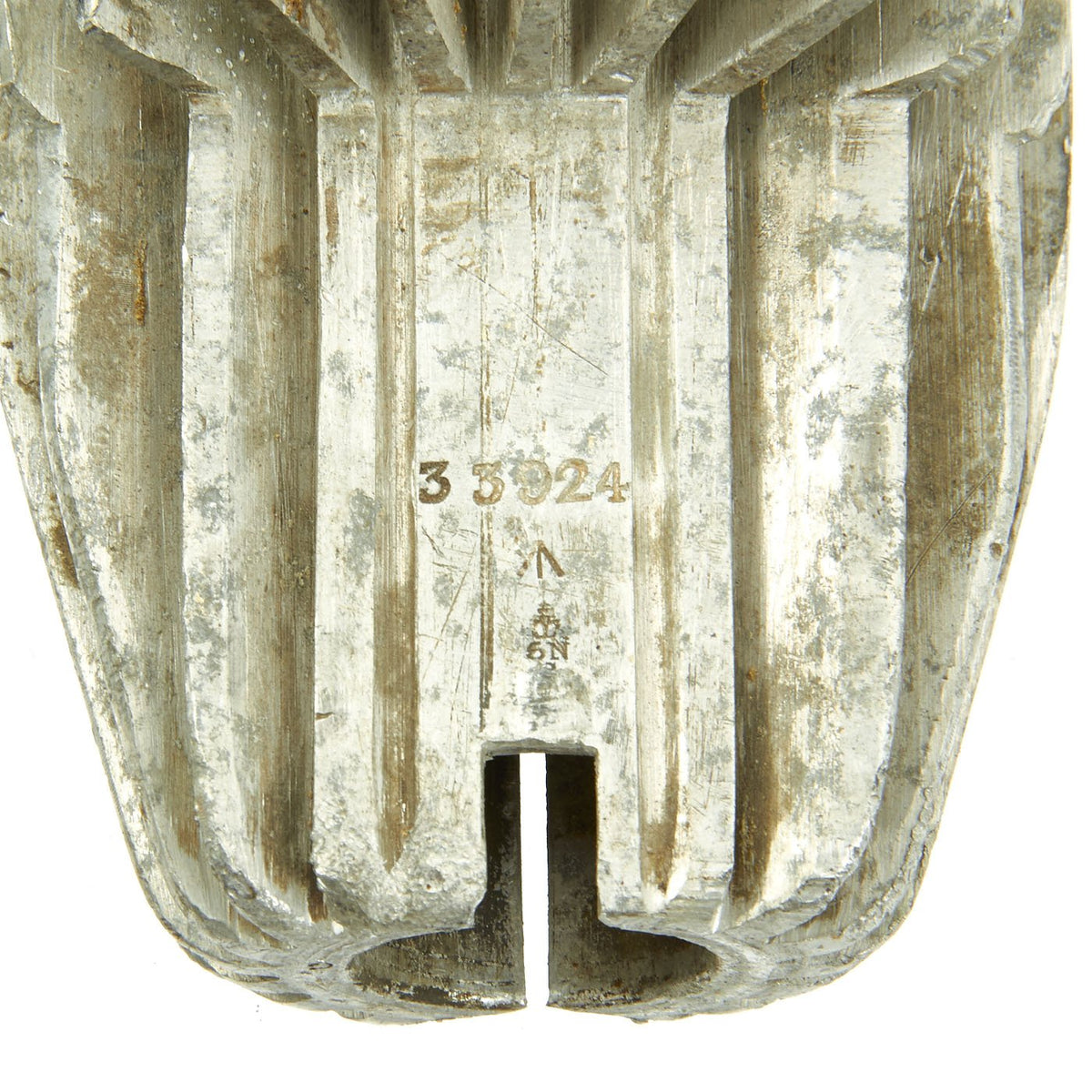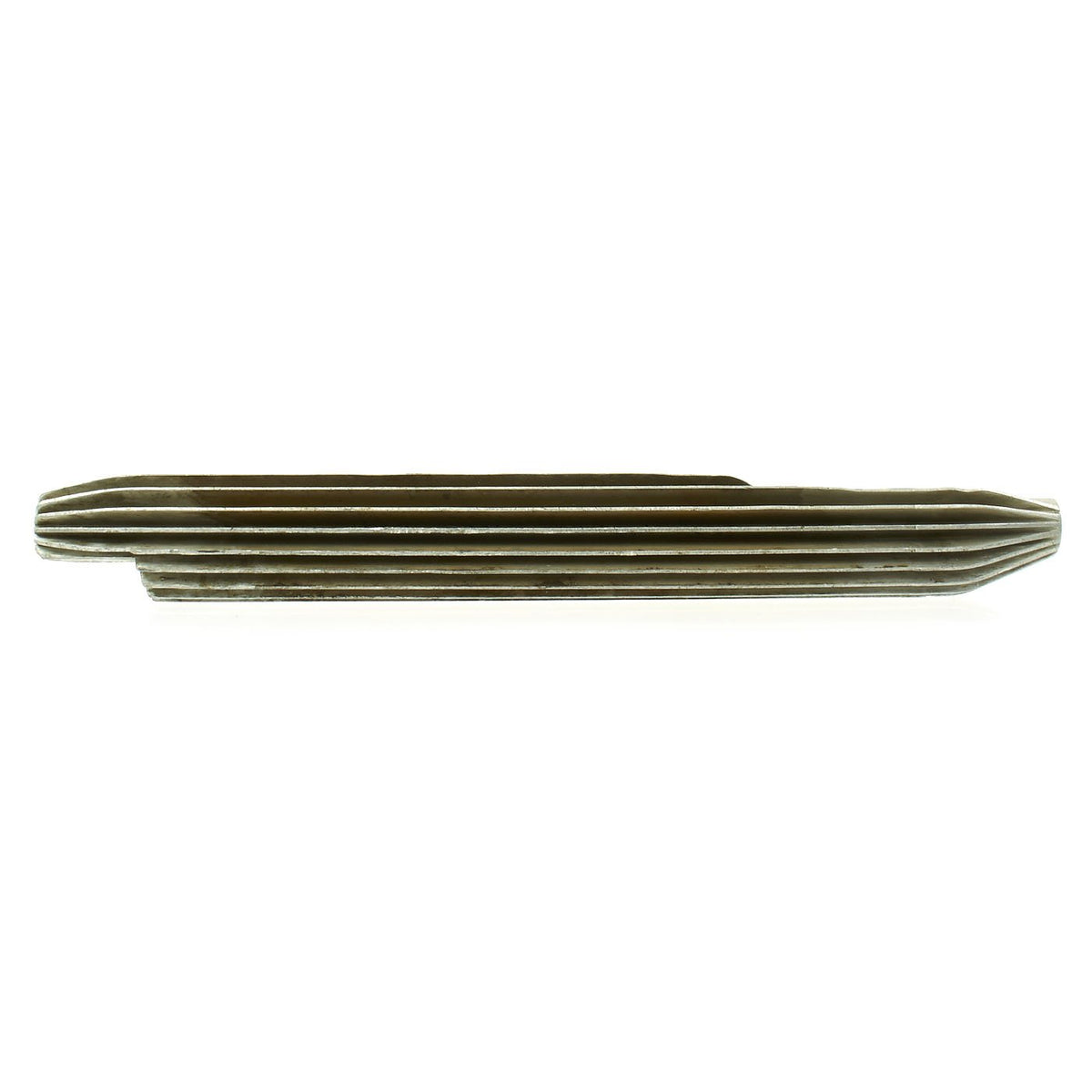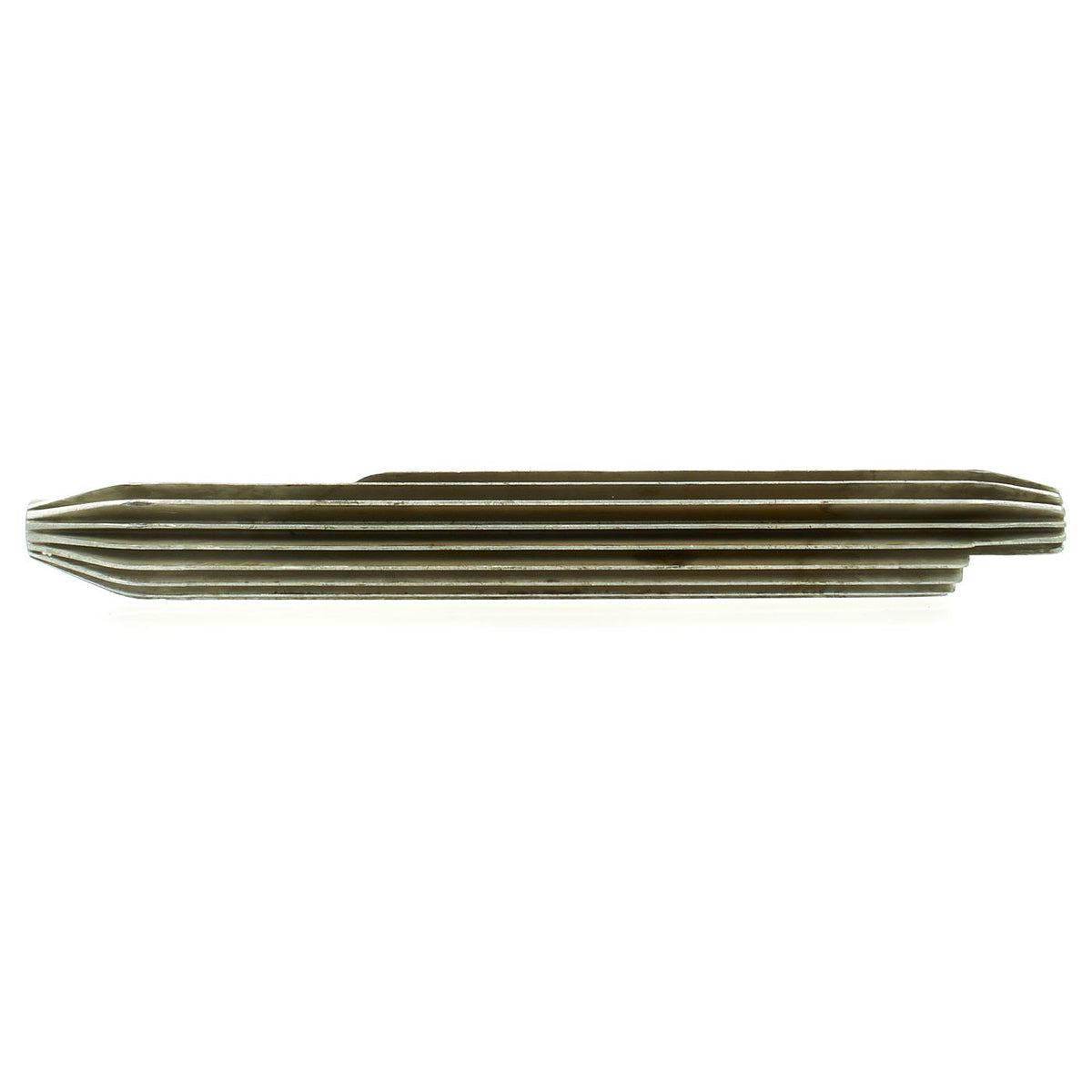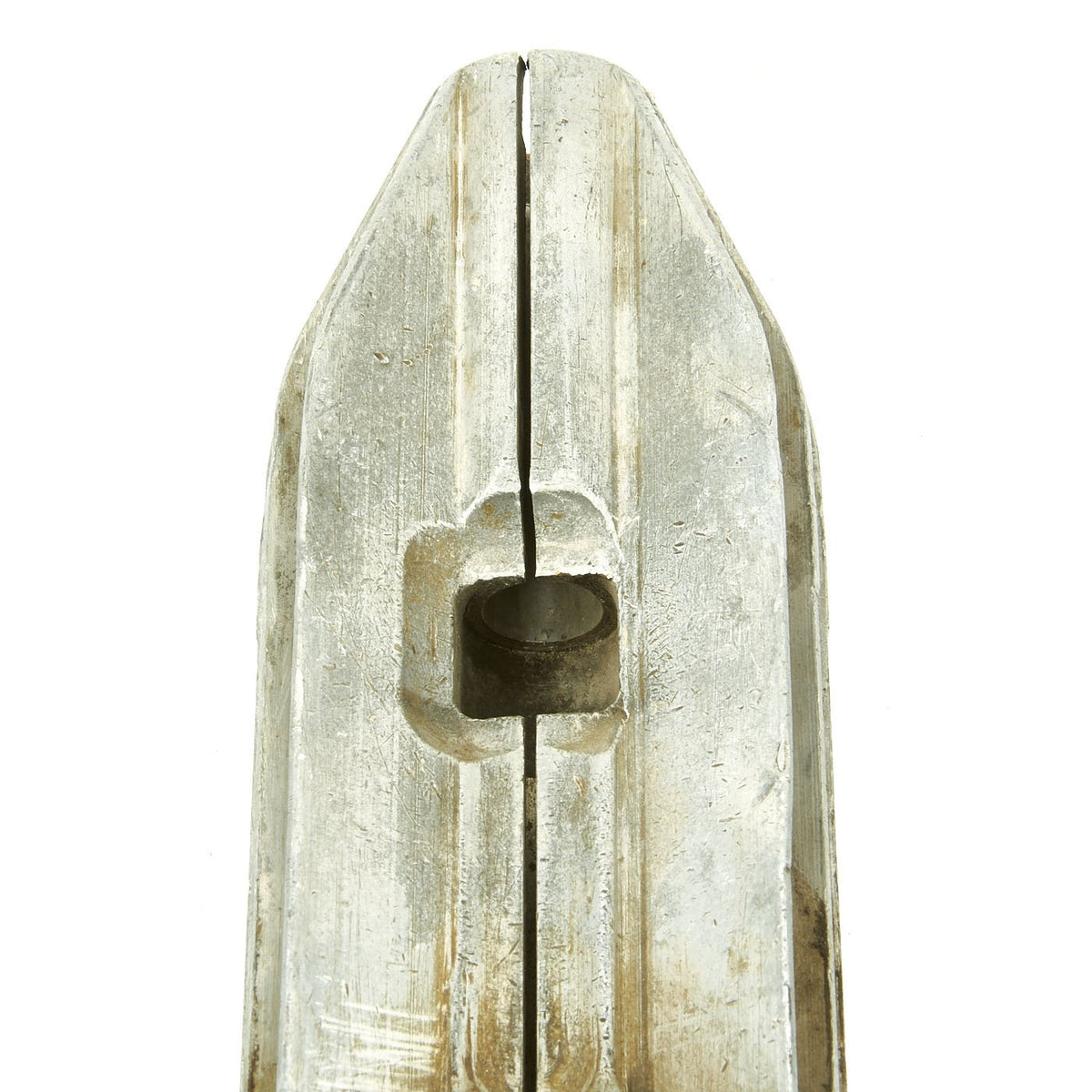Original British WWI Lewis Automatic Machine Gun Aluminum Barrel Radiator Original Items
$ 1.195,00 $ 298,75
Original Item: Only One Available. Over the years IMA has had several Lewis Guns available, and we managed to acquire an extra barrel radiator from one of these acquisitions. This is basically the “heat sink” for the barrel, which is inside the barrel jacket, helping increase the surface area and therefore the cooling ability. It measuers 23 3/4 inches long and is in very good condition, with serial number 33924 stamped on one end, over a “Broad Arrow” and British proof marks. It is a bit dirty from years of storage.
A very hard to find piece of a very desirable gun! These do not come along often at all, and this is the only example we have offered as a separate part!
The Lewis gun (or Lewis automatic machine gun or Lewis automatic rifle) is a World War I-era light machine gun of American design that was perfected and widely used by the British Empire. It was first used in combat in World War I, and continued in service with a number of armed forces through to the end of the Korean War. It is visually distinctive because of its wide tubular cooling shroud around the barrel and its top-mounted drum-pan magazine. It was commonly used as an aircraft machine gun, almost always with the cooling shroud removed, during both world wars.
History of the Lewis Gun:
The Lewis gun was invented by US Army Colonel Isaac Newton Lewis in 1911, based on initial work by Samuel Maclean. Despite its origins, the Lewis gun was not initially adopted by the American military—most likely because of political differences between Lewis and General William Crozier, the Chief of the Ordnance Department. Lewis became frustrated with trying to persuade the US Army to adopt his design and so (“slapped by rejections from ignorant hacks”, as he said), retired from the army. He left the United States in 1913 and headed to Belgium, where he established the Armes Automatique Lewis company in Liège to facilitate commercial production of the gun. Lewis had been working closely with British arms manufacturer The Birmingham Small Arms Company Limited (BSA) in an effort to overcome some of the production difficulties of the weapon. The Belgians bought a small number of Lewises in 1913, using the .303 British round, and in 1914, BSA purchased a licence to manufacture the Lewis machine gun in England, which resulted in Col. Lewis receiving significant royalty payments and becoming very wealthy. Lewis and his factory moved to England before 1914, away from possible seizure in the event of a German invasion. The Belgian Army acquired only a handful of his guns, probably only just in double figures. They were not on general issue in the Belgian Army. They were used only in a few forays by motor vehicles, south of Antwerp, against the flank of the invading German Army.
The onset of World War I increased demand for the Lewis gun, and BSA began production (under the designation Model 1914). The design was officially approved for service on 15 October 1915 under the designation “Gun, Lewis, .303-cal.” No Lewis guns were produced in Belgium during World War I; all manufacture was carried out by BSA in England and the Savage Arms Company in the US.
he first use of the Lewis in the War was by Belgium, in August and September 1914, when the small number available were fitted to a handful of touring and armoured cars and used in a few sorties against German patrols and troop columns. It is stated that as a consequence the Germans nicknamed the Lewis “The Belgian Rattlesnake,” but contemporary German references have not been found. The Lewis was not in service with the regular Belgian Army.
Great Britain officially adopted the Lewis gun in .303 calibre for land and aircraft use in October 1915, with the weapon beginning to be generally issued to the British Army’s infantry battalions on the Western Front in early 1916 as a replacement for the heavier and less mobile Vickers machine gun, the Vickers then being withdrawn from the infantry for use by specialist machine-gun companies. The US Navy and Marine Corps followed in early 1917, adopting the M1917 Lewis gun (produced by the Savage Arms Co.), in .30-06 caliber.
The US Army never officially adopted the weapon for infantry use and even went so far as to take Lewis guns away from US Marines arriving in France and replace them with the cheap, shoddy, and extremely unsatisfactory Chauchat LMG —a practice believed to be related to General Crozier’s dislike of Lewis and his gun. The US Army eventually adopted the Browning Automatic Rifle in 1917 (although it was September 1918 before any of the new guns reached the front). The US Navy and Marine Corps continued to use the .30-06 caliber Lewis until the early part of World War II.
The Russian Empire purchased 10,000 Lewis guns in 1917 from the British government, and ordered another 10,000 weapons from Savage Arms in the US. The US government was unwilling to supply the Tsarist Russian government with the guns and there is some doubt as to whether they were actually delivered, although records indicate that 5,982 Savage weapons were delivered to Russia by 31 March 1917. The Lewis guns supplied by Britain were dispatched to Russia in May 1917, but it is not known for certain whether these were the Savage-made weapons being trans-shipped through the UK, or a separate batch of UK-produced units.
British Mark IV tanks used the Lewis, replacing the Vickers and Hotchkiss used in earlier tanks. The Lewis was chosen for its relatively compact magazines, but as soon as an improved magazine belt for the Hotchkiss was developed, the Lewis was replaced by them in later tank models.
The Germans also used captured Lewis guns in both World Wars, and included instruction in its operation and care as part of their machine-gun crew training.
Despite costing more than a Vickers gun to manufacture (the cost of a Lewis gun in 1915 was £165, the Vickers cost about £100), Lewis machine guns were in high demand with the British military during World War I. The Lewis also had the advantage of being about 80% faster to build than the Vickers, and was a lot more portable; Accordingly, the British government placed orders for 3,052 guns between August 1914 and June 1915. By the end of World War I over 50,000 Lewis guns had been produced in the US and UK and they were nearly ubiquitous on the Western Front, outnumbering the Vickers by a ratio of about 3:1.
Deactivated magazine will be sent if not legal in destination location.
Fast Shipping with Professional Packaging
Thanks to our longstanding association with UPS FedEx DHL, and other major international carriers, we are able to provide a range of shipping options. Our warehouse staff is expertly trained and will wrap your products according to our exact and precise specifications. Prior to shipping, your goods will be thoroughly examined and securely secured. We ship to thousands clients each day across multiple countries. This shows how we're dedicated to be the largest retailer on the internet. Warehouses and distribution centres can be located throughout Europe as well as the USA.
Note: Orders with more than one item will be assigned a processing date depending on the item.
Before shipping before shipping, we'll conduct a thorough inspection of the items you have ordered. Today, the majority of orders will be delivered within 48 hours. The delivery time will be between 3-7 days.
Returns
The stock is dynamic and we cannot completely manage it because multiple stakeholders are involved, including our factory and warehouse. So the actual stock may alter at any time. It's possible that you may not receive your order once the order has been made.
Our policy is valid for a period of 30 days. If you don't receive the product within 30 days, we are not able to issue a refund or an exchange.
You can only return an item if it is unused and in the same state as the day you received it. You must have the item in its original packaging.
Related products
Uncategorized
Uncategorized
Uncategorized
Uncategorized
Uncategorized
Uncategorized
Uncategorized
Uncategorized
Uncategorized
Uncategorized
Uncategorized
Uncategorized
Uncategorized
Uncategorized
Uncategorized
Band of Brothers ORIGINAL GERMAN WWII Le. F.H. 18 10.5cm ARTILLERY PIECE Original Items
Uncategorized
Armoured Fighting Vehicles of the World: AFVs of World War One (Hardcover Book) New Made Items
Uncategorized
Angolan Rebel 1970s era 60mm Inert Display Mortar from Angolan Civil War Original Items
Uncategorized












































































